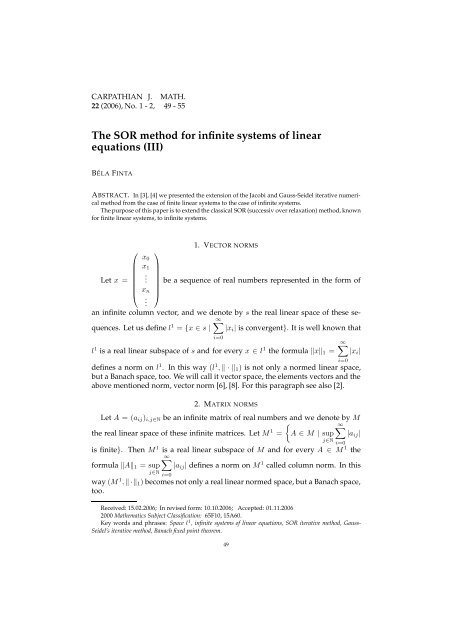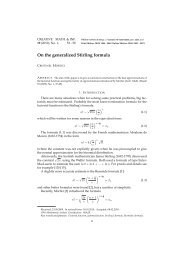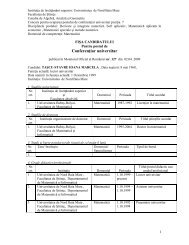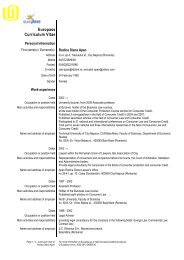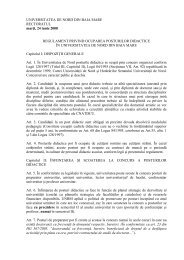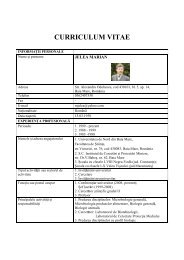The SOR method for infinite systems of linear equations (III)
The SOR method for infinite systems of linear equations (III)
The SOR method for infinite systems of linear equations (III)
Create successful ePaper yourself
Turn your PDF publications into a flip-book with our unique Google optimized e-Paper software.
CARPATHIAN J. MATH.22 (2006), No. 1 - 2, 49 - 55<strong>The</strong> <strong>SOR</strong> <strong>method</strong> <strong>for</strong> <strong>infinite</strong> <strong>systems</strong> <strong>of</strong> <strong>linear</strong><strong>equations</strong> (<strong>III</strong>)BÉLA FINTAABSTRACT. In [3], [4] we presented the extension <strong>of</strong> the Jacobi and Gauss-Seidel iterative numerical<strong>method</strong> from the case <strong>of</strong> finite <strong>linear</strong> <strong>systems</strong> to the case <strong>of</strong> <strong>infinite</strong> <strong>systems</strong>.<strong>The</strong> purpose <strong>of</strong> this paper is to extend the classical <strong>SOR</strong> (successiv over relaxation) <strong>method</strong>, known<strong>for</strong> finite <strong>linear</strong> <strong>systems</strong>, to <strong>infinite</strong> <strong>systems</strong>.Let x =⎛⎜⎝x 0x 1.x n..1. VECTOR NORMS⎞be a sequence <strong>of</strong> real numbers represented in the <strong>for</strong>m <strong>of</strong>⎟⎠an <strong>infinite</strong> column vector, and we denote by s the real <strong>linear</strong> space <strong>of</strong> these sequences.Let us define l 1 = {x ∈ s | |x i | is convergent}. It is well known∞∑thatl 1 is a real <strong>linear</strong> subspace <strong>of</strong> s and <strong>for</strong> every x ∈ l 1 the <strong>for</strong>mula ‖x‖ 1 =i=0∞∑|x i |defines a norm on l 1 . In this way (l 1 , ‖·‖ 1 ) is not only a normed <strong>linear</strong> space,but a Banach space, too. We will call it vector space, the elements vectors and theabove mentioned norm, vector norm [6], [8]. For this paragraph see also [2].i=02. MATRIX NORMSLet A =(a ij ) i,j∈N be an <strong>infinite</strong> matrix <strong>of</strong> real numbers and we denote by M{∞∑the real <strong>linear</strong> space <strong>of</strong> these <strong>infinite</strong> matrices. Let M 1 = A ∈ M | sup |a ij |j∈Ni=0is finite}. <strong>The</strong>n M 1 is a real <strong>linear</strong> subspace <strong>of</strong> M and <strong>for</strong> every A ∈ M 1 the∞∑<strong>for</strong>mula ‖A‖ 1 =sup |a ij | defines a norm on M 1 called column norm. In thisj∈Ni=0way (M 1 , ‖·‖ 1 ) becomes not only a real <strong>linear</strong> normed space, but a Banach space,too.Received: 15.02.2006; In revised <strong>for</strong>m: 10.10.2006; Accepted: 01.11.20062000 Mathematics Subject Classification: 65F10, 15A60.Key words and phrases: Space l 1 , <strong>infinite</strong> <strong>systems</strong> <strong>of</strong> <strong>linear</strong> <strong>equations</strong>, <strong>SOR</strong> iterative <strong>method</strong>, Gauss-Seidel’s iterative <strong>method</strong>, Banach fixed point theorem.49
50 Béla FintaCorollary 2.1. If <strong>for</strong> the matrix A =(a ij ) i,j∈N we have a ij =0<strong>for</strong> i>nand j>n,n ∈ N, then from the above we obtain the results in the finite dimensional space R n [1],[5].This space will be called matrix space and the above mentioned norm, matrixnorm. For this paragraph see also [2], [6], [8].3. THE COMPATIBILITY OF THE VECTOR AND MATRIX NORMSLet x ∈ s be a sequence <strong>of</strong> real numbers, and A =(a ij ) i,j∈N ∈ M an <strong>infinite</strong>matrix <strong>of</strong> real numbers.Definition 3.1. We will define the product A · x if <strong>for</strong> every i ∈ N the series∞∑a ij x j is convergent. In this case the resulting vector y = A · x is a columnj=0⎛vector with components y =⎜⎝∞∑⎞a 0j x jj=0∞∑a 1j x jj=0...∞∑a ij x j⎟j=0 ⎠.<strong>The</strong>orem 3.1. <strong>The</strong> vector norm ‖·‖ 1 defined on l 1 is compatible with the matrix norm‖·‖ 1 defined on M 1 , i.e. ‖Ax‖ 1 ≤‖A‖ 1 ·‖x‖ 1 <strong>for</strong> every x ∈ l 1 and every A ∈ M 1 .Pro<strong>of</strong>. We have:‖A · x‖ 1 ==≤∣ ∣∣∣∣∣ ∞∑∞∑∞∑ ∞∑a ij x j ≤ |a ij |·|x j | =∣j=0i=0 j=0∞∑ ∞∑∞∑ ∞∑|a ij |·|x j | = |x j |· |a ij |≤i=0j=0 i=0∞∑j=0|x j |·supj∈N∞∑i=0j=0|a ij | =supj∈Ni=0∞∑ ∞∑|a ij |· |x j | = ‖A‖ 1 ·‖x‖ 1 .i=0j=0□Corollary 3.2. If <strong>for</strong> the matrix A =(a ij ) i,j∈N we have a ij =0<strong>for</strong> i>nand j>n,n ∈ N, then from <strong>The</strong>orem 3.1 we reobtain the results in the finite dimensional space R n[1], [5].For this paragraph see also [2], [6], [8].
<strong>The</strong> <strong>SOR</strong> <strong>method</strong> <strong>for</strong> <strong>infinite</strong> <strong>systems</strong> <strong>of</strong> <strong>linear</strong> <strong>equations</strong> (<strong>III</strong>) 514. THE MATRIX NORM SUBORDINATED TO A GIVEN VECTOR NORMFor every x ∈ l 1 and A ∈ M 1 we have ‖Ax‖ 1 ≤‖A‖ 1 ·‖x‖ 1 according to<strong>The</strong>orem 3.1. If x ≠ θ l 1 (the null element <strong>of</strong> the vector space l 1 ), then ‖Ax‖ 1≤{ }‖x‖ 1‖Ax‖1‖A‖ 1 and we can define sup | x ∈ l 1 \{θ l 1} .‖x‖ 1It is known that this <strong>for</strong>mula defines a matrix norm on M 1 , which we call thematrix norm subordinated { to the vector norm } ‖·‖ 1 defined on l 1 and we denoteit by ‖A‖ ∗ ‖Ax‖11 =sup | x ∈ l 1 \{θ l 1} . It is immediately that ‖A‖ ∗ 1 ≤‖A‖ 1 ,‖x‖ 1<strong>for</strong> every A ∈ M 1 . Actually, we have<strong>The</strong>orem 4.2. ‖A‖ ∗ 1 = ‖A‖ 1.∞∑Pro<strong>of</strong>. We must prove that ‖A‖ ∗ 1 ≥‖A‖ 1 . From ‖A‖ 1 =sup |a ij | we obtain: <strong>for</strong>j∈Ni=0∞∑every ε>0 there exists j 0 ∈ N such that |a ij0 |≥‖A‖ 1 − ε. Let us choose thevector x ∈ l 1 such that all the components <strong>of</strong> x are zero except <strong>for</strong> the componentj 0 . So∣ ∣∣∣∣∣ ∞∑∞∑∞∑‖A · x‖ 1 =a ij x j = |a ij0 x j0 | =i=0 ∣j=0i=0(∞∑∞)∑= |a ij0 |·|x j0 | = |a ij0 | ·|x j0 |≥Consequentlyi=0i=0i=0≥ (‖A‖ 1 − ε) ·|x j0 | =(‖A‖ 1 − ε) ·‖x‖ 1 .‖Ax‖ 1≥‖A‖ 1 − ε,‖x‖ 1i.e.{ }‖A‖ ∗ ‖Ax‖11 =sup | x ∈ l 1 \{θ l 1} ≥‖A‖ 1 − ε,‖x‖ 1<strong>for</strong> every ε>0. This means that ‖A‖ ∗ 1 ≥‖A‖ 1.□Corollary 4.3. If <strong>for</strong> the matrix A =(a ij ) i,j∈N we have a ij =0<strong>for</strong> i>nand j>n,n ∈ N, then from <strong>The</strong>orem 4.2 we reobtain the results in the finite dimensional space R n[1], [5].For this paragraph see also [2], [6], [8].<strong>The</strong> above presented vector and matrix spaces will be used to extend the iterativeJacobi’s and Gauss-Seidel’s <strong>method</strong>s, from finite <strong>linear</strong> <strong>systems</strong> to the case<strong>of</strong> <strong>infinite</strong> <strong>systems</strong>. In this way we can study the <strong>linear</strong> stationary processes with<strong>infinite</strong> but countable number <strong>of</strong> parameters.
52 Béla Finta5. THE <strong>SOR</strong> METHOD FOR INFINITE SYSTEMS OF LINEAR EQUATIONSLet us consider the <strong>infinite</strong> system <strong>of</strong> <strong>linear</strong> <strong>equations</strong> Ax = b, where A ∈ Mand x, b ∈ s.Definition 5.2. For a given A ∈ M and b ∈ s we will say that x ∗ ∈ s is a solution<strong>of</strong> the <strong>infinite</strong> system <strong>of</strong> <strong>linear</strong> <strong>equations</strong> Ax = b if we have Ax ∗ = b.∞∑∞∑This means that the series a ij x ∗ j is convergent and we have a ij x ∗ j = b i ,j=0<strong>for</strong> every i ∈ N.Let us suppose that a ii ≠0<strong>for</strong> every i ∈ N and let us consider the constantsω i ∈ R \{0} <strong>for</strong> every i ∈ N. <strong>The</strong> initial system <strong>of</strong> <strong>linear</strong> <strong>equations</strong> Ax = b isequivalent to the following iterative system <strong>of</strong> <strong>linear</strong> <strong>equations</strong>:⎧∑∞ a 0j b 0x 0 =(1− ω 0 )x 0 − ω 0 x j + ω 0a 00⎪⎨⎪⎩.j=1x 1 = −ω 1a 10a 11x 0 +(1− ω 1 )x 1 − ω 1a 00∑∞j=2a 1ja 11x j + ω 1b 1x 2 = −ω 2a 20a 22x 0 − ω 2a 21a 22x 1 +(1− ω 2 )x 2 − ω 2.∑i−1a ijx i = −ω i x j +(1− ω i )x i − ω ia iij=0∞ ∑j=i+1a 11∑∞j=3a ija iix j + ω ib ia iij=0a 2ja 22x j + ω 2b 2a 22Using this system <strong>of</strong> <strong>linear</strong> <strong>equations</strong>, let us choose x 0 ∈ s and we generate thesequence (x k ) k∈N ⊂ s by the following iterative <strong>for</strong>mula:⎧∞∑x k+10 =(1− ω 0 )x k 0 − ω a 0j0 x k ja + ω b 0000(5.1)⎪⎨⎪⎩.j=1a 00x k+1 a 10∑∞1 = −ω 1 x k+10 +(1− ω 1 )x k a 1j1 − ω 1 x k b 1j + ω 1a 11 a 11 a 11x k+12 = −ω 2a 20a 22x k+10 −ω 2a 21a 22tx k+1.x k+1i∑i−1a ij= −ω i x k+1ja iij=0j=21 +(1−ω 2 )x k 2 −ω 2 ∞ ∑+(1− ω i )x k i − ω i∞∑j=i+1a ijj=3a iix k j + ω ia 2ja 22x k j +ω 2b 2a 22Consequently, starting from the vector x k , we generate the vector x k+1 by therecursion <strong>for</strong>mula x k+1 = B ω · x k + c.b ia ii
<strong>The</strong> <strong>SOR</strong> <strong>method</strong> <strong>for</strong> <strong>infinite</strong> <strong>systems</strong> <strong>of</strong> <strong>linear</strong> <strong>equations</strong> (<strong>III</strong>) 53Definition 5.3. <strong>The</strong> matrix A =(a ij ) i,j∈N is l 1 diagonal dominated if there existsthe positive real number λ > 0 such that <strong>for</strong> every j ∈ N we have∞∑λ|a jj | > |a ij |.i=0i≠jIt is immediately that A is l 1 diagonal dominated if and only if supj∈Na finite real number.Let us denote by λ := supj∈N∞∑∣ a ij ∣∣∣∣ isa jji=0i≠j∣ ∞∑a ij ∣∣∣∣ ,ω ∗ =sup{|ω i |/i ∈ N} ∈R and ω ∗∗ =a jji=0i≠jsup{|1 − ω i |/i∈ N} ∈R. Let us suppose ω ∗ · λ
54 Béla FintaConsequently:‖y‖ 1 ≤ ω ∗ λ‖x‖ 1 + ω ∗ λ‖y‖ 1 + ω ∗∗ ‖x‖ 1 ,which is equivalent to‖y‖ 1≤ ω∗ λ + ω ∗∗‖x‖ 1 1 − ω ∗ λ .This means that‖B ω x‖ 1 ‖y‖ 1‖B ω ‖ 1 = sup = sup ≤ ω∗ λ + ω ∗∗x≠θ l‖x‖1 1 x≠θ l‖x‖1 1 1 − ω ∗ λ < 1.Now we can apply the Banach fixed point theorem <strong>for</strong> the iteration map Φ:l 1 → l 1 , Φ(x) =B ω x + c. Indeed, Φ is a contraction, because‖Φ(x) − Φ(y)‖ 1 = ‖(B ω x + c) − (B ω y + c)‖ 1 = ‖B ω (x − y)‖ 1 ≤‖B ω ‖ 1 ‖x − y‖ 1 .This means that the sequence (x k ) k∈N is convergent in l 1 <strong>for</strong> every x 0 ∈ l 1 andits limit point x ∗ ∈ l 1 is the unique fixed point <strong>of</strong> Φ in l 1 , i.e. Φ(x ∗ )=x ∗ . SoB ω x ∗ + c = x ∗ , which is equivalent to Ax ∗ = b.□Corollary 5.4. If <strong>for</strong> the matrix A =(a ij ) i,j∈N we have a ij =0when i>n,j>nand b i =0<strong>for</strong> i>n,n∈ N, then we reobtain the <strong>linear</strong> system with finite number <strong>of</strong><strong>equations</strong> and finite number <strong>of</strong> unknowns. In this way from <strong>The</strong>orem 5.3 we obtain theclassical <strong>SOR</strong> iterative numerical <strong>method</strong> to solve finite <strong>systems</strong> <strong>of</strong> <strong>linear</strong> <strong>equations</strong> [7].In the following we consider the particular case when ω i = ω, <strong>for</strong> every i ∈ N.So, from (5.1) we can deduce: let us choose x 0 ∈ s and we generate the sequence(x k ) k∈N ⊂ s by the following iterative <strong>for</strong>mula:(5.2)⎧⎪⎨⎪⎩.∞ x k+10 =(1− ω)x k 0 − ω ∑ a 0jx k j + ω b 0a 00j=1x k+11 = −ω a 10a 11x k+10 +(1− ω)x k 1 − ωx k+12 = −ω a 20x k+10 − ω a 21x k+1a 22 a 22..x k+1i∑i−1= −ωj=0a 00∞∑a 1jx k j + ω b 1aj=2 11 a 11∞1 +(1− ω)x k 2 − ω ∑a ija iix k+1j +(1− ω)x k i − ω ∞ ∑In this case from <strong>The</strong>orem 5.3 we obtain:j=i+1j=3a ija iix k j + ω b ia iia 2ja 22x k j + ω b 2a 22|ω|λ + |1 − ω|Corollary 5.5. If < 1, (|ω|λ < 1) then the corresponding iterative1 −|ω|λsequence (x k ) k∈N given by (5.2) is convergent in l 1 <strong>for</strong> every x 0 ∈ l 1 . <strong>The</strong> limit pointx ∗ ∈ l 1 is the unique solution <strong>of</strong> the <strong>linear</strong> system Ax = b.
<strong>The</strong> <strong>SOR</strong> <strong>method</strong> <strong>for</strong> <strong>infinite</strong> <strong>systems</strong> <strong>of</strong> <strong>linear</strong> <strong>equations</strong> (<strong>III</strong>) 55In the following we consider the particular case, when ω i = ω =1<strong>for</strong> everyi ∈ N. So from (5.2) we can deduce: let us choose x 0 ∈ s and we generate thesequence (x k ) k∈N ⊂ s by the following iterative <strong>for</strong>mula:(5.3)⎧⎪⎨x k+10 = −∞∑j=1a 0ja 00x k j + b 0x k+11 = − a 10a 11x k+10 −a 00∞∑j=2x k+12 = − a 20a 22x k+10 − a 21a 22x k+1.x k+1i∑i−1a ij= − x k+1ja iij=0−a 1ja 11x k j + b 11 −∞∑j=i+1a 11∞∑j=3a 2ja 22x k j + b 2a 22a ija iix k j + b ia ii⎪⎩.From <strong>The</strong>orem 5.3 and Corollary 5.5 we obtain the author’s result, the Gauss-Seidel’s iterative <strong>method</strong> <strong>for</strong> <strong>infinite</strong> <strong>systems</strong> <strong>of</strong> <strong>linear</strong> <strong>equations</strong> [4]:Corollary 5.6. If λ< 1 2 , then the corresponding iterative sequence (xk ) k∈N given by(5.3) is convergent in l 1 <strong>for</strong> every x 0 ∈ l 1 . <strong>The</strong> limit point x ∗ ∈ l 1 is the unique solution<strong>of</strong> the <strong>linear</strong> system Ax = b.We can obtain similar results if we replace the space l 1 by the space l ∞ or l p ,<strong>for</strong> p ∈ (1, +∞).We mention that all these results are valid in the complex case, too.REFERENCES[1] Finta, B., A Remark about Vector and Operator Norms, Mathematical Magazine Octogon, Braşov, 6,No. 1, April, 1998, 58-60[2] Finta, B., A Remark about Vector and Matrix Norms (II), Buletin Ştiinţific, XV-XVI, Universitatea”Petru Maior”, Tg. Mureş, 2002-2003, 113-120[3] Finta, B., Jacobi’s <strong>The</strong>orem <strong>for</strong> Infinite System <strong>of</strong> Linear Equations, Pr<strong>of</strong>esor Gheorghe Fărcaşlavârsta de70 de ani, Volum omagial, Editura Universităţii ”Petru Maior” Tg. Mureş, 2004, 103-108[4] Finta, B., Gauss-Seidel’s <strong>The</strong>orem <strong>for</strong> Infinite System <strong>of</strong> Linear Equations (II), International Conference”European Integration Between Tradition and Modernity”, IETM First Edition, ”Petru Maior”University <strong>of</strong> Tg. Mures, 22-24 September 2005, Romania, 669-677[5] Horn, R. A., Johnson, C. R., Matrix Analysis, Cambridge University Press, Cambridge, 1990[6] Kantorovitch, L., Akilov, G., Analyse fonctionnelle, Éditions MIR, Moscou, 1981[7] Plato, R., Concise Numerical Mathematics, Graduate Studies in Mathematics, 57, AMS, 2003[8] Szidarovszky, F., Yakowitz, S., Principles and Procedures <strong>of</strong> Numerical Analysis, Plenum Press,New York and London, 1978DEPARTMENT OF MATHEMATICS”PETRU MAIOR”UNIVERSITY TG. MUREŞNICOLAE IORGA 1, 540088 TG. MUREŞ, ROMANIAE-mail address: fintab@upm.ro


